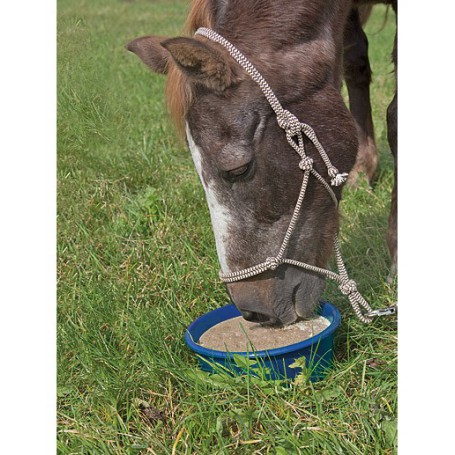Introduction to Okapi mineral feed
OKAPI Mineral Feed
Horses draw a large part of their mineral requirements from their basic feed, i.e. hay and pasture grass. However, not all minerals are always contained in sufficient quantities. This can vary greatly with the soil contents, but also with the harvest time and the drying conditions for the hay as well as, and of course with the vegetation. In order to prevent mineral deficiency symptoms, a good mineral feed should therefore be offered regularly in order to compensate for imbalances in the basic feed if necessary.
But what makes a good mineral feed? On the one hand, the fact that all the minerals and trace elements that the organism needs for a smooth metabolism are contained. Because you don't analyze every single bale of hay, so you never know exactly what might be at shortage. In addition, it has proven its worth to offer the minerals in inorganic form. This is because these are detected by specialized receptors in the intestinal wall and are therefore only included as needed.
The body has stores for all minerals, which are filled in times of good supply and emptied in times of deficiency. If the storage for a mineral is well filled, then it is not absorbed from the food in larger quantities, but excreted together with the feces. This avoids oversupply and thus additional strain on the kidneys.
Quite different with the administration of organic minerals. These cannot be "pre-sorted" in the intestine. In the case of a proven deficiency, for example for zinc or copper, then it makes sense to "trigger" this selection mechanism, but if a mineral feed has organic minerals in it then this will provide a considerable additional burden on the liver and kidney function.
That is why we have consciously chosen the inorganic variants, which can be sufficiently selected and metabolized by the horses.
In order to avoid oversupply, we have also opted for the granulated (G) form for almost all mineral feed (except mineral concentrate P).
Only 2% molasses have to be added as a dust binder, so that the horse cannot inhale mineral dust during feeding. Compared to sugar levels in the hay and other feed, this is a manageable amount of sugar given per meal. The extremely low molasses content ensures that the mineral does not taste "delicious", but actually only tastes like "mineral". Thus, our mineral feed is only absorbed by most horses as needed.
It is best to fill a small amount in a plastic bucket and hold it to your horse. If it needs mineral, it can take two to three mouths of it, then put the bucket away again. If the bucket is stubbornly ignored by the horse, then one can assume that the mineral stores are full and can also leave the feed in the cupboard for two to three weeks before it is offered again.
The mineral lick (G) also do not contain sugar adhesives, but are produced in a special process in which the starting materials react with each other in such a way that they get a gypsum-like consistency. Nevertheless, the mineral licks should initially only be offered under supervision, e.g. when you are cleaning the stable or during the removal of feces, so that they are not overly frequented due to unrecognized mineral deficiency or boredom. If the lick is stubbornly ignored by all horses, it can also be left at leisure in the stable and you can observe how the mineral demand fluctuates throughout the year.
Our granulated mineral feed does not have carriers that make the food taste "delicious". We use grape seed flour as a carrier, so our mineral feed often smells a bit nutty. In addition, we deliberately refrain from using organic selenium, brewer's yeast and other ingredients that we believe do not belong in the diet of horses. We try to put our mineral feed together in such a way that the horses are adequately cared for without putting additional strain on the metabolism. If you are not sure which mineral feed is suitable for your horse, then you can also get a feed test done to find out what the horse exactly needs.


